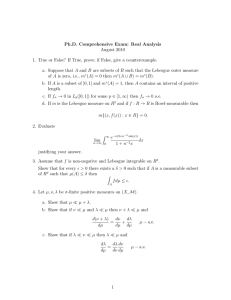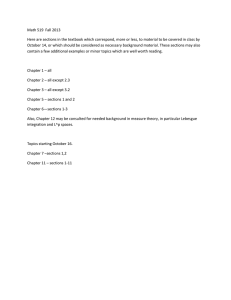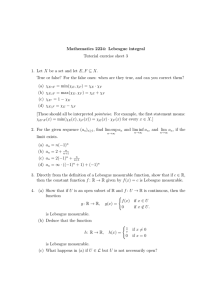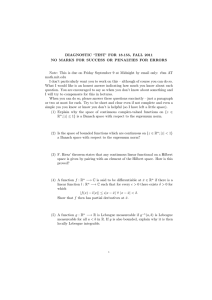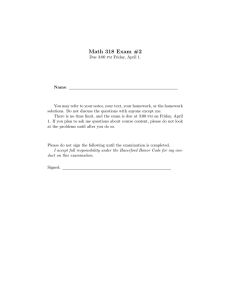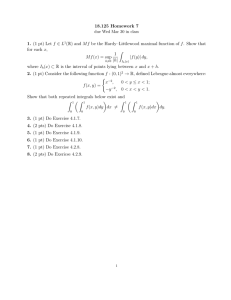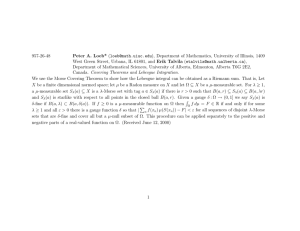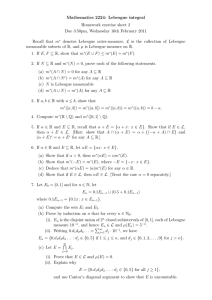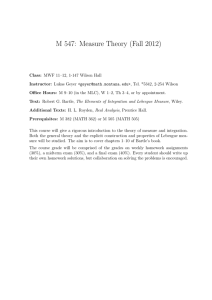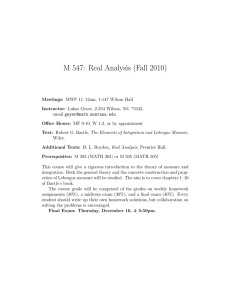Homework 1 - Math 541, Spring 2016
advertisement
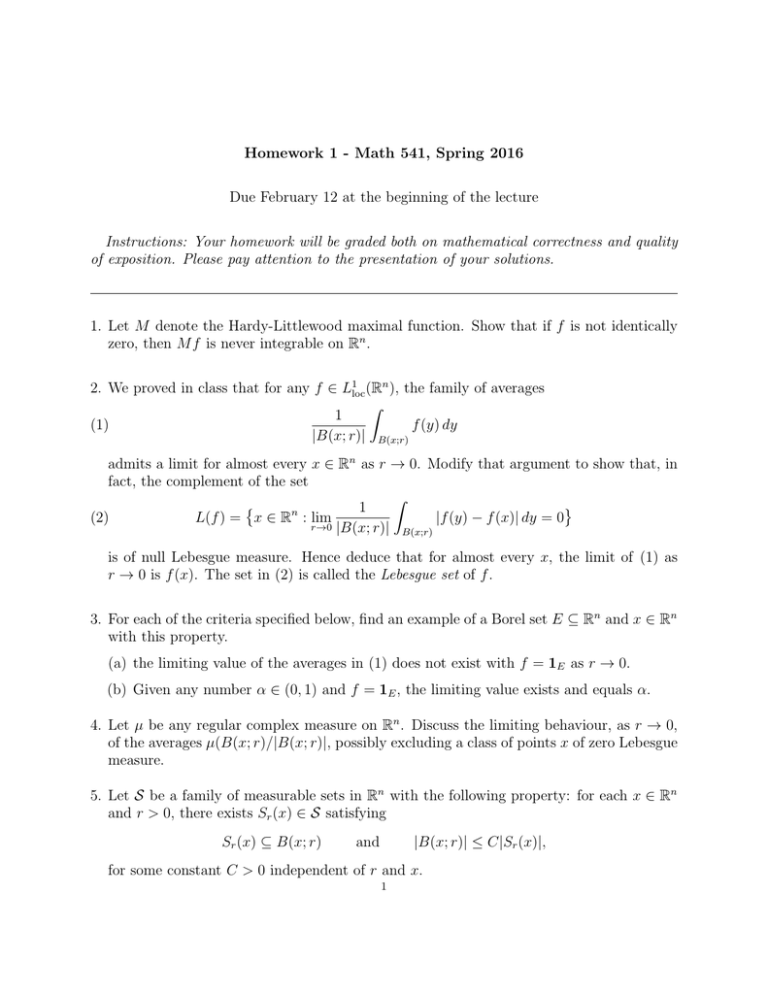
Homework 1 - Math 541, Spring 2016
Due February 12 at the beginning of the lecture
Instructions: Your homework will be graded both on mathematical correctness and quality
of exposition. Please pay attention to the presentation of your solutions.
1. Let M denote the Hardy-Littlewood maximal function. Show that if f is not identically
zero, then M f is never integrable on Rn .
2. We proved in class that for any f ∈ L1loc (Rn ), the family of averages
Z
1
(1)
f (y) dy
|B(x; r)| B(x;r)
admits a limit for almost every x ∈ Rn as r → 0. Modify that argument to show that, in
fact, the complement of the set
Z
1
n
(2)
L(f ) = x ∈ R : lim
|f (y) − f (x)| dy = 0
r→0 |B(x; r)| B(x;r)
is of null Lebesgue measure. Hence deduce that for almost every x, the limit of (1) as
r → 0 is f (x). The set in (2) is called the Lebesgue set of f .
3. For each of the criteria specified below, find an example of a Borel set E ⊆ Rn and x ∈ Rn
with this property.
(a) the limiting value of the averages in (1) does not exist with f = 1E as r → 0.
(b) Given any number α ∈ (0, 1) and f = 1E , the limiting value exists and equals α.
4. Let µ be any regular complex measure on Rn . Discuss the limiting behaviour, as r → 0,
of the averages µ(B(x; r)/|B(x; r)|, possibly excluding a class of points x of zero Lebesgue
measure.
5. Let S be a family of measurable sets in Rn with the following property: for each x ∈ Rn
and r > 0, there exists Sr (x) ∈ S satisfying
Sr (x) ⊆ B(x; r)
|B(x; r)| ≤ C|Sr (x)|,
and
for some constant C > 0 independent of r and x.
1
2
(a) Give at least two distinct examples of families of sets S that meets the two requirements described above. Also provide at least two examples of S which satisfies the
first condition but does not meet the second.
(b) Show that
Z
1
lim
|f (y) − f (x)| dy = 0
r→0 |Sr (x)| S (x)
r
for every point x in the Lebesgue set of f .
6. The Hardy Littlewood maximal operator M is of fundamental importance in part because
it controls many other operators of interest arising in a variety of contexts. We illustrate
this in the context of the Dirichlet problem for Laplace’s equation.
(a) Suppose that g : Rd → [0, ∞] is radial and nonincreasing. In other words, g(x) =
h(|x|) with h(r1 ) ≥ h(r2 ) for 0 ≤ r1 ≤ r2 . Show that f ∗ g(x) ≤ ||g||1 M f (x) for all x
and all non-negative f .
(b) Recall the Poisson kernel for the upper half-space Rn+1
= {(x, t) : x ∈ Rn , t > 0}:
+
pt (x) = cn t−n (1 + |t−1 x|2 )−
n+1
2
.
Verify that for any bounded continuous f or for f ∈ Lp , p ∈ [1, ∞], the function
u(x, t) = f ∗ pt (x) obeys Laplace’s equation 4u = 0 on Rn+1
+ .
(c) Let’s focus now on the boundary behaviour of u. Show that u(x, t) → f (x) as t → 0
uniformly on compact sets if f is a bounded continuous function. Prove convergence
in Lp as t → 0 if f ∈ Lp (Rn ).
(d) What can we say about the pointwise convergence of u to f ? Show that u(x, t) → f (x)
as t → 0 non-tangentially for almost every x ∈ Rn . This means that for almost every
x, and every r > 0,
u(y, t) → f (x)
as (y, t) → (x, 0), with
(y, t) ∈ Γr (x) = {(y, t) ∈ Rn+1
: |x − y| < rt}.
+
